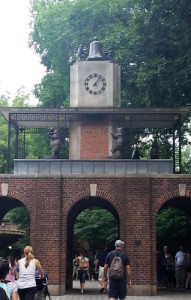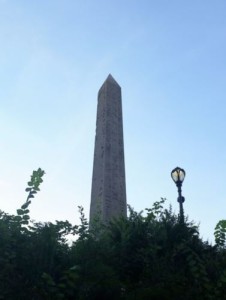I’ve known that there was a zoo in Central Park for probably as long as I’ve known that there was a Central Park. I wasn’t sure where it was, but I suspected it was close to the center, pretty much where it turns out that the reservoir is. I don’t know why I imagined it was there. Partly it might be because it seemed that a zoo should take up a pretty decent amount of space, I think, and tucked away in a corner didn’t seem like it would be big enough for a zoo.
The movie Madagascar didn’t help that notion, by the way. Animals like lions, zebras, hippos, and giraffes need lots of space. According to the Association of Zoos and Aquariums Lion (Panthera leo) Care Manual, a lion needs at least 0.22 acres. That’s just a little smaller than the average lot size for a home in the American suburbs. Turns out that the Central Park Zoo doesn’t have any lions, zebras, hippos, or giraffes. There isn’t enough room for them. Just about the only parts of the zoo in the movie that look like they do in real life are the sea lion pool, which really is in the center of the zoo, and the clock with the arches underneath it. The clock, called the Delacorte Clock, is off to one side, rather in the middle. In fact, while researching this post, I found that the zoo from the movie is more similar to the zoo as it was before they remodeled it in the 1980s. The brick buildings with the arches and the enclosures with bars are very prominent in pictures from before 1980.

The history of the Central Park Zoo goes back to the mid-19th century when a bear cub was given to a messenger boy who worked in the park. Eventually, park employees collected other animals, and the city formed a menagerie. There was nothing like a menagerie or a zoo in the original plans for the park, which the architects, Frederick Law Olmsted and Calvert Vaux, had made. Vaux suggested the menagerie be moved to the perimeter of the park between 77th and 81st Streets, where the American Museum of Natural History stands today. Olmsted suggested putting the zoo in the North Meadow. They broke ground for the new menagerie, but after the first foundations were laid, construction stopped and the menagerie ended up in the building that had previously held the arsenal for the New York State Militia, in the southeast corner of the park.
I wonder if there are any kind of cropmarks visible where those old foundations were laid. I recently had the experience of seeing a sort of cropmark (though from the ground level) in Lockhart State Park, and can’t help but think that there might just be some kind of difference in the grass of the North Meadow where the old foundations are under the dirt.
In 1934, the haphazard menagerie that had accumulated in Central Park was replaced by a new six-acre zoo, which was constructed in less than a year. The centerpiece of the new zoo was a sea lion pool, which is still there today. The sea lion pool was unusual for the era, because the designers looked at the way that sea lions live and designed it accordingly. These days, ideally every zoo has habitats designed in a similar way (though the San Antonio Zoo has fallen behind just a bit on that score — more on that in a future post).
In the 1980s, they renovated the zoo, getting rid of the old enclosures with the bars and designing new habitats that were more in keeping with the ways the animals live in the wild. This is also the era in which the zoo got rid of all of its large animals, sending them to zoos that had more space and could better care for them. The only large animals they kept were a pair of polar bears, each of which were euthanized when they developed inoperable tumors. The old polar bear habitat was later renovated and now houses two grizzly bears.
The current zoo, which opened in 1988, houses over 130 species in its relatively small area. One of the most popular, from what I saw when I was there, were the penguins. There was barely room to move in the penguin house and this is likely for two reasons. One, of course, is, as mentioned before, Madagascar (though we never did see the penguins smile and wave). The other is that for a time the Central Park Zoo’s penguin habitat had a gay couple, Roy and Silo, who made the news and also were the subject of a children’s book, And Tango Makes Three, about Roy and Silo raising a chick together (which also made the news). Roy and Silo split up when Silo fell for a new, female, penguin.
The zoo layout is kind of erratic. Visitors enter from the southwestern side and then the visitors go around the central part of the zoo, the Central Garden, in a clockwise direction. There are a whole bunch of exhibits behind the western part of the Central Garden. Somehow, following the natural flow of the zoo ended up with us missing the turn for the red panda exhibit, so once we were done with the penguins (which should have been the last stop), we looked at the map and had to backtrack to the turnoff for the pandas. Overall, though, it is a very nice zoo considering the space they have available (I do wish the red pandas had a little more space). The layout and traffic pattern of the zoo, combined with the fact that we had to backtrack, led me to completely miss the Arsenal Building that used to be the home of the menagerie. I didn’t even get an accidental picture of it.
I quite liked the Tropic Zone building. It had a lot of birds and also had a nice little display of short-tailed fruit bats. I love bats. It’s always fun to watch them fly, and they eat mosquitoes. Anything that eats mosquitoes is my friend.
The Central Park Zoo is quite hilly. This means that handicapped visitors might need additional assistance to get to some of the exhibits, and others might be off-limits entirely, depending on the wheelchair user’s stamina (and possibly his or her concern for the laws of gravity). The Central Garden and all of the buildings of the Central Park Zoo are wheelchair accessible.
References:

